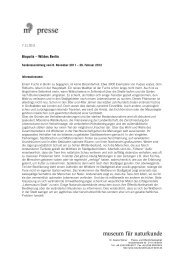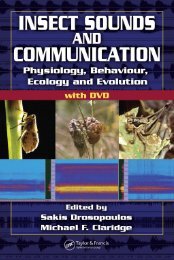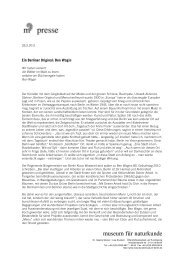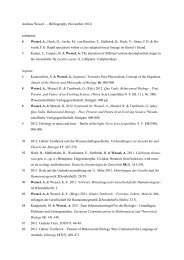Glaubrecht et al 2005.pdf - Download.naturkundemuseum-berlin.de ...
Glaubrecht et al 2005.pdf - Download.naturkundemuseum-berlin.de ...
Glaubrecht et al 2005.pdf - Download.naturkundemuseum-berlin.de ...
Create successful ePaper yourself
Turn your PDF publications into a flip-book with our unique Google optimized e-Paper software.
Mitt. Mus. Nat.kd. Berl., Zool. Reihe 81 (2005) 2 / http://museum-zool.wiley-vch.<strong>de</strong> 149<br />
It was only consequent from this, <strong>al</strong>beit erroneous,<br />
hypothesis that Thiele (1929) did not inclu<strong>de</strong><br />
aplacophorans in his Handbuch <strong>de</strong>r Systematischen<br />
Weichtierkun<strong>de</strong>, which started<br />
accordingly with the Loricata Schumacher, 1817<br />
(¼ Polyplacophora Gray, 1821) interpr<strong>et</strong>ed by<br />
him as most primitive and true representatives of<br />
the phylum Mollusca. In the second volume of<br />
his Handbuch, Thiele (1935: 1074) for the last<br />
time outlined the phylogeny of the Mollusca,<br />
stating that the Solenogastres cannot be viewed<br />
as <strong>de</strong>rived from shelled anim<strong>al</strong>s due to, for example,<br />
their peculiar hautmuskelschlauch<br />
(p. 1073) and because of other characteristic anatomic<strong>al</strong><br />
features, thus repeating that they are to<br />
be perceived as “Vermes” and exclu<strong>de</strong>d from<br />
the Mollusca (p. 1074).<br />
Two conclusions can be drawn from this. First,<br />
evi<strong>de</strong>n<strong>de</strong>ntly, Thiele and his contemporaries<br />
struggled with quite similar problems of molluscan<br />
classification as we still do over a century of zoologic<strong>al</strong><br />
systematics later, viz. monophyly vs. paraphyly<br />
of the aplacophorans, their relationship to<br />
Polyplacophora within the Amphineura and/or<br />
Aculifera concept and the ancestry of the Mollusca<br />
within the m<strong>et</strong>azoans, in particular their relationship<br />
with Annelida. And second, Thiele’s erroneous<br />
assumption of Solenogastres being<br />
“Vermes” resulted in the <strong>de</strong>position of aplacophoran<br />
materi<strong>al</strong> of the ZMB, and hence the late<br />
re-discovery of it, in the “Vermes” <strong>de</strong>partment<br />
that initiating this annotated type cat<strong>al</strong>ogue.<br />
The first h<strong>al</strong>f century of research on aplacophoran<br />
classification was dominated by the practice<br />
to consi<strong>de</strong>r <strong>al</strong>l “worm-like” molluscs as Solenogastres,<br />
thus including <strong>al</strong>so those taxa later to<br />
be distinguished as Caudofoveata; see e.g. treatments<br />
by Simroth (1893b), Thiele (e.g. 1902c,<br />
1913c), Nierstrasz (1908) and Heath (1911).<br />
Thiele (1913c) distinguished four taxa among this<br />
paraphyl<strong>et</strong>ic group, the Cha<strong>et</strong>o<strong>de</strong>rmatidae, Neomeniidae,<br />
Proneomeniidae, and Lepidomeniidae.<br />
Later, Thiele (1932) suggested to separate five<br />
families within the aplacophorans (<strong>al</strong>l consi<strong>de</strong>red<br />
by him to represent Solenogastres), viz. Neomediidae,<br />
Proneomeniidae, Gymnomeniidae, Lepidomediidae<br />
and Cryst<strong>al</strong>lophrissontidae. The latter,<br />
however, represents Cha<strong>et</strong>o<strong>de</strong>rmomorpha<br />
according to current knowledge which were subsequently<br />
separated by Bo<strong>et</strong>tger (1956); see e.g.<br />
Fischer-Pi<strong>et</strong>te & Franc (1960) and S<strong>al</strong>vini-Plawen<br />
(1967).<br />
Following Thiele’s era, Sigurd Hoffman (1949)<br />
not only contributed essenti<strong>al</strong>ly new information<br />
on the then wi<strong>de</strong>ly neglected aplacophoran<br />
groups but <strong>al</strong>so discussed at length phylogen<strong>et</strong>ic<br />
pathways and higher classification based on comparative<br />
investigations. Others, such as in Germany<br />
Hans Hoffmann (1929, 1951) stated not to<br />
separate aplacophorans from the Mollusca and<br />
proposed to view the Solenogastres as most “primitive”<br />
group within this phylum. It was then<br />
Bo<strong>et</strong>tger (1956) and later in particular S<strong>al</strong>vini-<br />
Plawen (1967, and subsequent publications) who<br />
took up, after <strong>al</strong>most h<strong>al</strong>f a century of neglectance<br />
of this important molluscan group, again<br />
the controversies as to the monophyly and phylogeny<br />
of “Aplacophora”. In the absence of cladistic<br />
an<strong>al</strong>yses, most authors long followed the<br />
gener<strong>al</strong> assignment of <strong>al</strong>l “worm shaped” molluscs<br />
as two cla<strong>de</strong>s Solenogastres or Neomeniomorpha<br />
(or Ventroplicida Bo<strong>et</strong>tger, 1956 which<br />
is a later naming) and Caudofoveata or Cha<strong>et</strong>o<strong>de</strong>rmomorpha<br />
within a monohylum Aplacophora.<br />
In contrast to these classifications of<br />
“Aplacophora” or “Aculifera”, S<strong>al</strong>vini-Plawen<br />
(e.g. 1972, 1985, 1991) has, early and repeatedly,<br />
argued that aplacophorans are paraphyl<strong>et</strong>ic or<br />
diphyl<strong>et</strong>ic, respectively (see below).<br />
Furthermore, <strong>de</strong>spite revision (S<strong>al</strong>vini-Plawen<br />
1978) the systematic relationships remained<br />
partly unresolved within Solenogastres, and the<br />
status of some families was poorly un<strong>de</strong>rstood,<br />
as was recently shown, for example within the<br />
Cavibelonia by S<strong>al</strong>vini-Plawen (2004). Earlier<br />
suggestions to separate three families most likely<br />
did not reflect natur<strong>al</strong> phylogen<strong>et</strong>ic lineages (S<strong>al</strong>vini-Plawen<br />
1967). According to the systematization<br />
suggested by S<strong>al</strong>vini-Plawen (1978; see <strong>al</strong>so<br />
phylogram in S<strong>al</strong>vini-Plawen & Steiner 1996: 31),<br />
four or<strong>de</strong>rs are to be distinguished within the Solenogastres,<br />
viz. Pholidoskepia, Neomeniamorpha<br />
(both as Aplotegmentaria) and Sterrofustia<br />
plus Cavibelonia (these two as Pachytegmentaria).<br />
Thus, the Cavibelonia, in which 11 genusgroup<br />
or families are now distinguished, replaced<br />
the Proneomeniidae s.l. and most of Neomeniidae<br />
s.l. in former systems. For discussion and references<br />
see S<strong>al</strong>vini-Plawen (1978, 2003, 2004).<br />
This systematization is followed herein; see section<br />
C for a classification of the ZMB type materi<strong>al</strong>.<br />
Phylogen<strong>et</strong>ic an<strong>al</strong>yses<br />
For sever<strong>al</strong> <strong>de</strong>ca<strong>de</strong>s now two hypotheses have<br />
been discussed as to the classification reflecting<br />
phylogen<strong>et</strong>ic relationships of the two aplacophoran<br />
taxa, Solenogastres (or neomenioids) and<br />
# 2005 WILEY-VCH Verlag GmbH & Co. KGaA, Weinheim






